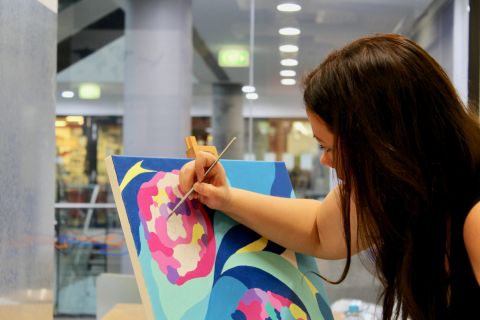
- 08:00
- St Heliers St Gallery, Abbotsford Convent, Saint Heliers Street, Abbotsfo
- Australian Regenerative Medicine Institute
During 2017 we offered an artist in residence program at the Australian Regenerative Medicine Institute (ARMI), inviting nine talented artists to each spend a week exploring the theme of regeneration whilst being immersed in the research environment.
They experienced cutting edge science first hand, took part in experiments and picked the brains of our brilliant scientists. They were also allowed to experiment with their art practice and incorporated techniques from the lab into their work. In turn, they inspired and challenged us with their curious and unique way of viewing our work and taught us exciting new ways of communicating science by creating beautiful art inspired by what they saw.
This exhibition is a showcase of the work produced during the 2017 #ARMIarts program.
All artwork is for sale, and funds raised from ticket and art sales during this exhibition will go directly back to ARMI to fund important research into regenerative medicine and disease.
View details on the Abbortsford Convent website.
Below are two examples of the artwork available for purchase at the exhibition
Be Courageous Be Kind – Elena Theodoridi.
Chalk, acrylic, pen pencil, watercolour.
In a clockwise order around outer perimeter: Zebrafish embryo, Turritopsis Dohrnii (the immortal jellyfish), Red sea urchin, starfish, Bamboo sharks, Shark embryos, Axolotl, Hydra, Zebrafish.
In a clockwise order within inner circle: Field mouse, Lisianthus, chicken, Old Tjikko spruce tree.
Zebrabow – Celeste Wrona.
Ink on paper.
Zebrabow is my visual representation of the awe inspiring beauty of the colours, textures and patterns of this genetically modified fish that was created by a post doc researcher at ARMI to study the origin of muscle fibres. Each of the individual different coloured shapes are a single muscle fibre, each differs in colour because the stem cells in the zebrabow fish have an introduced gene that gives each stem cell a different fluroescent marker. Allowing each cell to be ‘tagged’ with the same colour as the parent cell so that you can trace them back to the stem cells they originated from. This tool is used for studying a phenomenon known as ‘clonal drift’ which is where as the fish gets older, one particular stem cell will become more dominant at supplying cells to the growing muscle fibre.
